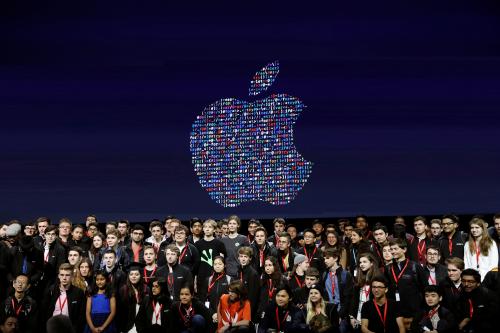Since last October, when dozens of women went public with accusations of harassment and assault against movie mogul Harvey Weinstein, the problem of gender imbalance in the workplace has become a white-hot topic of national (and international) discussion.
Yet the issue is not just about sexual harassment and #MeToo. While harrowing stories of boorish sexual pressure sparked the conversation, a much broader debate has gained force focused on the wider problem of women’s—and minorities’—unequal access to work, opportunity, and pay in the American workplace.
Most notably, the issue has flared in the technology industry, where former Uber employee Susan Fowler posted about rampant gender bias and former Google engineer James Damore fueled the debate with a memo suggesting men were better suited than woman for certain tech jobs. With technical skills increasingly important in the labor market, in this respect, data and insights about women’s access to technical skills and jobs have become vital for assessing—and improving—women’s economic opportunity across all parts of a digitalizing nation.
And now, with Amazon announcing its top 20 finalists for its second headquarters in North America, which will bring along 50,000 tech-related jobs and an expected investment of $5 billion into the selected city, the issue of gender imbalance in the tech-oriented workforce is more important than ever.
Given that, it’s worth taking a look at the detailed occupational data from our recent report, Digitalization and the American Workforce, which throw some new light on the mixed status of women’s digital progress.
What do our data show? Based on a 1 to 100 scoring of the digital content of 545 occupations developed using O*NET’s detailed surveys of actual workers, our data provide a mixed and sometimes surprising view of the interplay between female and male workers’ skills and employment progress.
For starters, our data show that while the lack of women in many critical and well-paying occupations continues to garner attention, women are now slightly ahead of men as a whole when it comes to developing the digital skills increasingly essential for employment, whether in high-end tech or low-end retail. Overall, on this measure, women now occupy jobs with a slightly higher mean digitalization score of 48 compared to a mean job score of 45 for men.

Underlying this digital edge, moreover, is the fact that women have historically been overrepresented in tens of millions of administration, social service, and health jobs that, while not intensely digital, are middling and increasingly digital. As depicted in the bar chart above, women now occupy 55.4 percent of business and financial operations jobs (2016 digital score of 62); 73.7 percent of health care practitioner and technical jobs; and 75.9 percent of office and support positions (digital score of 56). Similarly strong female presence also exists in such occupational groups as community and social services, education and training, health care support, and personal care, which are all more than 60 percent female.

Along these lines, women now have established a sizable beachhead in an array of large mid-digital occupational groups—especially in administration, health and personal care, and education—that contain numerous and varied interpersonal jobs; often provide career stability; and that are projected to remain resilient and grow in the face of automation. To that extent, women’s skills and occupational profile retain undeniable strengths that look better than before given recent thought about the future of work.
And yet, with that said, the occupational mosaic looks more mixed when we focus on the highly digital occupations that our research shows are most likely to bring the greatest benefits to workers, industries, and cities.
To be sure, women’s overall digital skills have increased rapidly, with the share of women working in the 45 highly digital occupations for which we have time-series data increasing from 1.3 percent in 2002 to more than 10.4 percent in 2016. Primarily driving the change was women’s upskilling combined with the increased digital demands of large service industries in need of millions of financial managers, medical and health managers, and customer service representatives.

But for all that, women’s share of the overall highly digital skills pool has not increased significantly. Instead, thanks to men’s equally fast upskilling, women remain just slightly better represented in the high-skill occupational tier, at 48 percent of total tier employment, than they were in 2002.
Turning to the lucrative, fast-growing, and socially significant computer and math sector, the picture is similarly mixed. On the positive side, women have markedly increased their share of such occupations as database administration, computer operations, and operations research analysis. Many of these occupations have digital scores around 80 and see female presence approaching or exceeding 50 percent after 15 years of share growth. Moreover, women now comprise as much as 36 percent of the occupational segment’s employment in larger metros like Sacramento (33.4 percent), New Orleans (31.2 percent), Baltimore (30.9 percent) and Washington, DC (30.7 percent), although the shares are much lower in West Coast tech hubs like San Francisco, San Jose, and Seattle. So that’s progress.

However, the story is not so bright for some of the largest and most central occupations in tech—including computer programming and computer and information systems management. Even after years of solid growth women comprise just a quarter of hardware engineers. Meanwhile, women remain grossly underrepresented in computer programming and as computer and information systems managers. According to Brookings’ data, while women hold just 22.6 and 25.5 percent of those positions, respectively, their shares of such jobs are actually going down, and have slumped by 5.5 and 5.0 percent since 2002. These numbers, we would add, are very much in line with the kinds of numbers being released in the diversity reports and Equal Employment Opportunity reports of Big Tech companies like Google or Facebook.
Which is to say, the “bro”-centric culture of tech appears very much entrenched—and documented by Brookings’ numbers—at least when it comes to “hero” jobs like programming.
As to what should be done about these trends, our work stresses the importance of two distinct but related agendas for better connecting women (and all groups) to the digital skills that are now a prerequisite for success in virtually all sectors of the economy. Along these lines, our analysis highlights two priorities: expanding the high-skill IT talent pipeline, at the high end of the skills continuum, and expanding basic exposure to entry-level tech skills, especially among under-represented groups. Along these lines, our work has stressed the importance of competency based education and training approaches; gender– and ethnically oriented “bootcamps” and code programs like Girls Who Code, Black Girls Code, or Hackbright Academy; as well as broad entry-level tech exposures such as are being scaled up by Microsoft and Google.
And yet, our data—with female skills increasing but their share of programming and other high-tech occupations going in the wrong direction—suggest that current skills-based solutions won’t solve the nation’s gender parity problems. It says something, after all, that women’s presence in highly digital tech and engineering occupations remains patchy despite the hundreds of female-oriented coding programs and “women in STEM” programs in universities. That reality makes it clear, as notes technology historian Marie Hicks here and here, that purely skills-oriented reform efforts—with their assumption that male-dominated workplaces are meritocracies—are going to be inadequate.
Instead, as Hicks and other reformers argue, real progress will likely only occur when the broader cultural and historical reasons for workplace sexism are addressed. And for that to be accomplished, say Hicks and others, more women and marginalized groups are going to need to be brought into organizations at high levels, with the power to change things, even if this means hiring people from allied fields and industries. Today, health industries and occupations—even the most technical ones—have a long history of female management and employment. Now perhaps managers from those industries will be invited in to help more women progress in tech and engineering industries.
Only then will the nation’s firms and industries truly link the nation’s full availability of talent to the opportunity that will unleash it to make America more prosperous.
See here for a complete ranking of women’s share of Computer & Mathematical occupations across all metro areas.
The Brookings Institution is committed to quality, independence, and impact.
We are supported by a diverse array of funders. In line with our values and policies, each Brookings publication represents the sole views of its author(s).









Commentary
Gender bias plays out in the digital workforce, but not in every industry
January 18, 2018